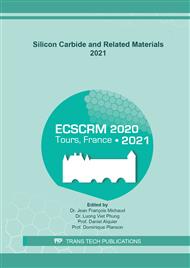[1]
Okamura, Katsuya, and Ken Takayama. High frequency power supply with 3.3 kV SiC-MOSFETs for accelerator application., Materials Science Forum. Vol. 897. Trans Tech Publications Ltd, (2017).
DOI: 10.4028/www.scientific.net/msf.897.685
Google Scholar
[2]
Alves, Luciano FS, et al. SIC power devices in power electronics: An overview., 2017 Brazilian Power Electronics Conference (COBEP). IEEE, (2017).
DOI: 10.1109/cobep.2017.8257396
Google Scholar
[3]
Castelletto, Stefania, and Alberto Boretti. Silicon carbide color centers for quantum applications., Journal of Physics: Photonics 2.2 (2020): 022001.
DOI: 10.1088/2515-7647/ab77a2
Google Scholar
[4]
Ivady, Viktor, et al. Theoretical model of dynamic spin polarization of nuclei coupled to paramagnetic point defects in diamond and silicon carbide., Physical Review B 92.11 (2015): 115206.
DOI: 10.1103/physrevb.92.115206
Google Scholar
[5]
Fisicaro, Giuseppe, et al. Genesis and evolution of extended defects: the role of evolving interface instabilities in cubic SiC., Applied Physics Reviews 7.2 (2020): 021402.
DOI: 10.1063/1.5132300
Google Scholar
[6]
Seo, Hosung, et al. Quantum decoherence dynamics of divacancy spins in silicon carbide., Nature Communications 7.1 (2016): 1-9.
Google Scholar
[7]
Yang, Wen, and Ren-Bao Liu. Quantum many-body theory of qubit decoherence in a finite-size spin bath., Physical Review B 78.8 (2008): 085315.
DOI: 10.1103/physrevb.78.129901
Google Scholar
[8]
Chalasinski, Grzegorz, and Malgorzata M. Szczesniak. Origins of structure and energetics of van der Waals clusters from ab initio calculations., Chemical Reviews 94.7 (1994): 1723-1765.
DOI: 10.1021/cr00031a001
Google Scholar
[9]
Giannozzi, Paolo, et al. QUANTUM ESPRESSO: a modular and open-source software project for quantum simulations of materials., Journal of physics: Condensed matter 21.39 (2009): 395502.
Google Scholar
[10]
Onizhuk, Mykyta, et al. Probing the coherence of solid-state qubits at avoided crossings., PRX Quantum 2.1 (2021): 010311.
DOI: 10.1103/prxquantum.2.010311
Google Scholar
[11]
Pickard, Chris J., and Francesco Mauri. All-electron magnetic response with pseudopotentials: NMR chemical shifts., Physical Review B 63.24 (2001): 245101.
DOI: 10.1103/physrevb.63.245101
Google Scholar
[12]
Varini, Nicola, et al. Enhancement of DFT-calculations at petascale: nuclear magnetic resonance, hybrid density functional theory and Car-Parrinello calculations., Computer Physics Communications 184.8 (2013): 1827-1833.
DOI: 10.1016/j.cpc.2013.03.003
Google Scholar


